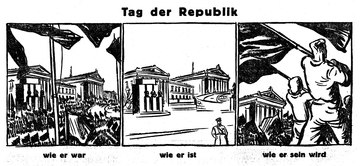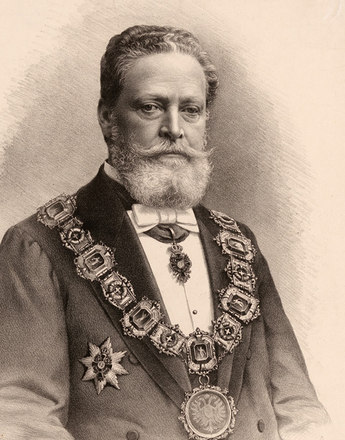The New State in Search of its National Holiday: 12 November as the Site of Political Dividing Lines
The proclamation of the republic meant that new symbols of state had to be found in order to distinguish it from the old order. The law passed on 19 April 1919 made 12 November the national holiday. However, the degree of identification with the new holiday varied, reflecting the differences between the political camps.
When the republic was founded there was a large degree of consensus regarding the break with Austria’s monarchic past. On the basis of this the new national holiday could be decided on unanimously ‘in everlasting memory of the proclamation of the free state of German-Austria’. But when it came to finding a name for the bank holiday the differences already began to appear: while in the jargon of the Social Democrats the day was known as the ‘Celebration of the Republic’ or the ‘Day of the Republic’, the Christian Socialists avoided any name which included the word ‘republic’ and left the name as ‘National Holiday’ or simply ‘12 November’. The former political grouping had very much stronger emotional ties with the new form of state than was the case for the party members and supporters of the Christian Socialists. Moreover, the Social Democrats regarded a bourgeois democracy as a transitional stage to a social republic.
The first anniversary of the republic was marked on the one hand by the outcome of the negotiations in Saint-Germain and on the other by the precarious situation in supplying the population with food. As a result there was no official state ceremony, but only a speech given by Karl Renner, in which he reminded his listeners that thanks to the trust granted by the Austrian people, it had been possible to confront ‘the onslaught of the Communist movement on the one hand and the tremendous upheavals taking place abroad on the other’. In the following years it was mainly the Social Democrats who celebrated the day with parades and other ceremonies, while the Christian Socialists – more or less as a counter demonstration and the continuation of a Habsburg tradition – organised pilgrimages in honour of the canonised Babenberg margrave Leopold III. They simply brought forward by three days the commemoration of the day of his death, 15 November. This was a way of stressing the unity of the state and the Catholic church. After the coalition collapsed in 1920 official Austria marked the day with military parades only. The two camps also held separate ceremonies to mark the fifth anniversary of the republic: Chancellor Seipel stayed away from the ceremonies in Vienna and took part in a ceremony at the theological faculty in Salzburg. In 1923 and in the following years there were attempts to disrupt the parades. As a result it was decided to have only a guard of honour in front of the presidential chancellery in Vienna. After the events surrounding the fire at the Palace of Justice in July 1927 the Social Democrats used 12 November as an occasion to mobilize opposition to the Christian Socialist camp.
In 1928 the mood became optimistic again, and the Christian Socialist government took the tenth anniversary of the founding of the republic as an opportunity to hold numerous official events. The Ringstrasse boulevard was, however, turned into a location for parades by Social Democrat workers, and the monument to the republic, which commemorated exclusively Social Democrat personalities, was unveiled next to the Parliament building. After the abolition of parliament in 1933 the Social Democrats used the day to get round the ban on demonstrations by organising a ‘walk’ on the Ringstrasse, in the course of which there were mass arrests. Finally, after the civil war in February 1934 the national holiday on 12 November was abolished and replaced by a holiday on 1 May. This proclamation also amounted to the symbolic burial of the republic.
Translation: Leigh Bailey
Hanisch, Ernst: Das Fest in einer fragmentierten politischen Kultur: Der österreichische Staatsfeiertag während der Ersten Republik, in: Lehnert, Detlef (Hrsg.): Politische Teilkulturen zwischen Integration und Polarisierung. Zur politischen Kultur in der Weimarer Republik, Opladen 1990, 43-60.
Köstenberger, Julia: 12. November – Gedenktag der Republik. Ein verlorener Staatsfeiertag, in: Karner, Stefan (Hrsg.): Österreich – 90 Jahre Republik. Beitragsband der Ausstellung im Parlament. Innsbruck, Wien u.a. 2008, 609-620
Quotes:
„the onslaught of the Communist movement ...": Wiener Zeitung vom 12.11.1919, 1, zitiert nach: Köstenberger, Julia: 12. November – Gedenktag der Republik. Ein verlorener Staatsfeiertag, in: Karner, Stefan (Hrsg.): Österreich – 90 Jahre Republik. Beitragsband der Ausstellung im Parlament. Innsbruck, Wien u.a. 2008, 609-620 (Translation)
-
Chapters
- 12 November 1918 as a Site of Memory
- The New State in Search of its National Holiday: 12 November as the Site of Political Dividing Lines
- Austria, the Country without a National Anthem
- Disputed Zones: Monuments and Street Names
- Myths and Narratives: ‘The Rest is Austria!’ … or something like that
- Myths and Narratives: ‘The Reluctant State’ and ‘The State that Nobody Wanted’
- No Role to Play and yet part of Austria’s Heritage: the Habsburgs after 1918







